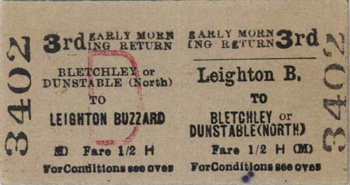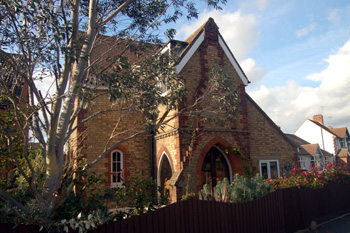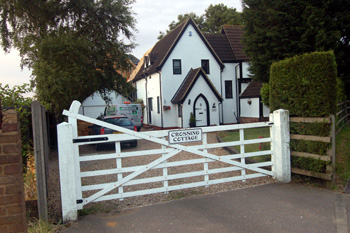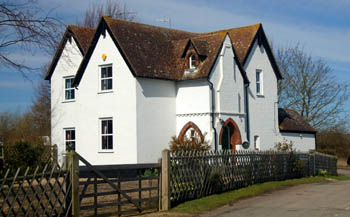The Dunstable Railway in Linslade

Leighton Buzzard to Dunstable railway ticket [Z298/56]
The main line from London to Birmingham, running through Linslade with a stop at Leighton Buzzard station opened in 1838. Ten years later a branch line from Leighton Buzzard to Dunstable opened, on 1st June. This line was built by the London and North Western Railway Company under chief engineer Robert Stephenson, son of George Stephenson and co-designer and builder of the locomotive Rocket.

Site of the Wing Road level crossing October 2008
The Act of Parliament necessary to allow the purchase of land by the London and Birmingham Railway Company (which merged with several other companies to form the LNWR in 1846) was passed in 1845. The railway opened in 1848. The line left the main line just south of Leighton Buzzard Station and ran down what is now Stephenson Close and crossed the Wing Road at a level crossing which, like all the level crossings, had a crossing keeper's house nearby. The keeper's cottage was demolished in the late 20th century. The track then ran down the modern Cedars Way until reaching another level crossing on Mentmore Road (originally called Ledburn Road), the keeper's cottage for this crossing is still there, just north of the line of the track.

Mentmore Road crossing cottage October 2008
At this point the track continued in what are now the houses and back gardens of Mentmore Gardens. The track crossed the Grand Union Canal and the River Ouzel via a bridge which is still there, about a quarter of a mile north of the northernmost point of Tiddenfoot Waterside Park. On crossing the River Ouzel the track entered Bedfordshire and the parish of Leighton Buzzard. It then ran in a straight line crossing Grovebury Road just south of the modern junction with Chartmoor Road and Penley Way taking a slight curve south through what is now Grovebury Industrial Estate, an industrial area even in the late 19th and early 20th century, which included a number of factories, quarries and the Leighton Buzzard Gas Works. The track crossed Billington Road at the modern roundabout at the Chartmoor Road junction. Again, the crossing keeper's house survives, just north of the line of the track. The railway then ran in a straight line through the modern housing estate east of Billington Road before leaving the parish and following the line of the modern A505, built three decades after the closure of the railway, at the slight northern curve the road takes east of its roundabout junction with Billington Road.

Billington Road crossing cottage June 2008
Before arriving in Dunstable the railway had stops for Billington, Stanbridge (in the parish of Totternhoe) and Houghton Regis. The London and North Western Railway was absorbed by the London, Midland and Scottish Railway in 1922 and in 1948 all railways were merged into the nationalised British Rail. The Dunstable Line was, not surprisingly, since it only covered eight miles, considered uneconomic and closed on 2nd July 1962 and its tracks gradually removed.
 Stanbridgeford station March 2008
Stanbridgeford station March 2008
Fred Cockman, in his book The Railway Age in Bedfordshire gives examples of timetables including one for July 1890 showing that a train leaving Leighton Buzzard took between nine and ten minutes to arrive in Stanbridgeford and then a further six or seven minutes to arrive in Dunstable (reverse times were between five and seven minutes from Dunstable to Stanbridgeford and then another ten minutes to Leighton Buzzard).